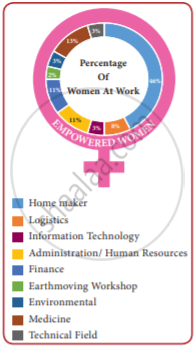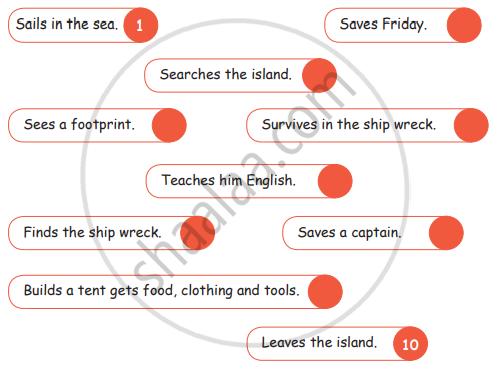Advertisements
Advertisements
प्रश्न
Which language do you use to talk to elderly relatives in your family?
उत्तर
I speak in Hindi to talk to the elderly relatives in my family.
(A model answer has been provided for students' reference. It is strongly recommended that students prepare the answer on their own.)
APPEARS IN
संबंधित प्रश्न
Does the poem have a consistent rhyme scheme?
Read the text below and summarise it.
The Great Desert Where Hippos Once Wallowed
The Sahara sets a standard for dry land. It’s the world’s largest desert. Relative humidity can drop into the low single digits. There are places where it rains only about once a century. There are people who reach the end of their lives without ever seeing water come from the sky.
Yet beneath the Sahara are vast aquifers of fresh water, enough liquid to fill a small sea. It is fossil water, a treasure laid down in prehistoric times, some of it possibly a million years old. Just 6,000 years ago, the Sahara was a much different place.
It was green. Prehistoric rock art in the Sahara shows something surprising: hippopotamuses, which need year-round water.
“We don’t have much evidence of a tropical paradise out there, but we had something perfectly liveable,” says Jennifer Smith, a geologist at Washington University in St Louis.
The green Sahara was the product of the migration of the paleo-monsoon. In the same way that ice ages come and go, so too do monsoons migrate north and south. The dynamics of earth’s motion are responsible. The tilt of the earth’s axis varies in a regular cycle — sometimes the planet is more tilted towards the sun, sometimes less so. The axis also wobbles like a spinning top. The date of the earth’s perihelion — its closest approach to the sun — varies in cycle as well.
At times when the Northern Hemisphere tilts sharply towards the sun and the planet makes its closest approach, the increased blast of sunlight during the north’s summer months can cause the African monsoon (which currently occurs between the Equator and roughly 17°N latitude) to shift to the north as it did 10,000 years ago, inundating North Africa.
Around 5,000 years ago the monsoon shifted dramatically southward again. The prehistoric inhabitants of the Sahara discovered that their relatively green surroundings were undergoing something worse than a drought (and perhaps they migrated towards the Nile Valley, where Egyptian culture began to flourish at around the same time).
“We’re learning, and only in recent years, that some climate changes in the past have been as rapid as anything underway today,” says Robert Giegengack, a University of Pennsylvania geologist.
As the land dried out and vegetation decreased, the soil lost its ability to hold water when it did rain. Fewer clouds formed from evaporation. When it rained, the water washed away and evaporated quickly. There was a kind of runaway drying effect. By 4,000 years ago the Sahara had become what it is today.
No one knows how human-driven climate change may alter the Sahara in the future. It’s something scientists can ponder while sipping bottled fossil water pumped from underground.
“It’s the best water in Egypt,” Giegengack said — clean, refreshing mineral water. If you want to drink something good, try the ancient buried treasure of the Sahara.
Staff Writer, Washington Post
Identify the common characteristics shared by tribal communities all over the world.
Why is the poem entitled 'Hawk Roosting'?
Taking off from Forster’s references to Emily Bronte, Sterne and Proust, discuss the treatment of time in some of the novels you have read.
Answer in your own words.
What did Revathi discover about her balsam plants?
Think and answer in your own words.
What could be the age group of the speaker in the poem?
Read 'The City Planners' by Margaret Atwood.
Read the story aloud (or present it) in groups of three - the narrator, the peacock, and the crane.
“A Midsummer-Night’s Dream” is one of the best examples of Shakespeare’s Comedy of Errors. Comment.
Collect as many pictures as you can, or draw diagrams of all the sources you have listed above. Make a scrapbook using them.
Find out the following with the help of your teacher and the internet.
Rain in countries like the UK which experience spring-summer-autumn-winter.
Think and answer:
Why are the sights said to ‘fly’?
Complete the following phrases with the help of the poem.
- ______ music
- ______ rivers
- ______ breeze
- ______ lake
- ______ citron-trees
Which of the words and phrases in the poem will you use in a realistic description?
Put a tick mark against the ones you will use.
- little
- shining tail
- golden scale
- cheerful
- grin
- claws
- gently smiling
- jaws
Form groups of five. Discuss how you can complete the rest of the story without referring to Part II of the story.
Say whether you agree or disagree.
The children would have behaved well on the train if their aunt had scolded them harshly.
In what season does the story take place?
Read the following line from the poem and answer the question that follow.
Let me but live my life from year to year, With forward face and unreluctant soul; Not hurrying to, nor turning from the goal; Not mourning for the things that disappear.
Identify the rhyme scheme of the given lines.
Read the data below and answer the following question.

Choose the correct answer.
What is the difference between the percentage of women working in logistics and Medicine?
Identify the character/speaker.
I must find out why he's in such a hurry!
What is the difference between this toy train and a normal train?
Imagine you are the girl and give a different ending to the story.
Vicky was an active boy.
The hen-pigeon got dry _______ for the bird catcher.
Identify the character or the speaker.
“Oh no! What shall I do now?”
Why did the bird catcher need fire?
Arrange the actions of Robinson by numbering from 1 to 10.

What did the leader see on the river?
What should we vow for?
